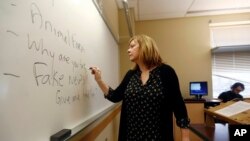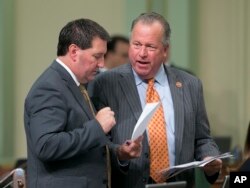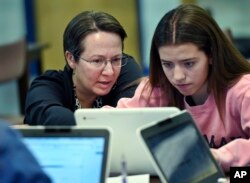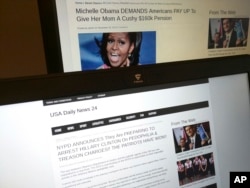Last week California Governor Jerry Brown signed into state law a bill that mandates the California Department of Education provide media literacy resources on its website, to help teachers and students navigate the maze of information on the internet.
California State Senator Bill Dodd, a Democrat representing the Napa Valley, authored the bill.
“We already require critical thinking skills in our schools. By giving students the proper training to analyze the media they consume, we can empower them to make informed decisions,” Dodd said in a statement.
Dodd told VOA this week that his media literacy efforts were based on a Stanford University study in 2016. It showed that 80 percent of middle school students didn’t recognize an ad that was masquerading as a news story despite it being labeled “sponsored content.” The study also found that high school students had trouble telling the difference between the real Fox News Facebook site and a fake account mimicking the conservative news outlet.
First steps in media literacy
When the Stanford study first came out, Dodd said, he introduced a bill that suggested media literacy curriculum for students, but he said lawmakers didn’t want to appropriate the funds for it. Dodd said he realized then that he was going to have to dial his ambitions back a bit, to a set of recommendations endorsed by the state.
“This was as good as we were going to get for this year,” Dodd said. “Once these modules are put online, there’ll be an opportunity to go even further.” Connecticut, Rhode Island, New Mexico, and Washington state have also passed legislation on media literacy instruction in schools. Several others are considering it.
On Monday, Dodd is to appear at a forum at the University of California Davis, discussing media literacy with students, professors and other interested parties. His goal is simple.
“If it can engender some more ideas for how we can improve this, I’ll consider that a victory,” Dodd said.
Separating good information from bad
Author and former television journalist Dan Kilday has written a young-adult book called “Molly Warner: School Reporter” to address some challenges kids and adult journalists face in the tricky world of today’s media. His sixth-grade protagonist channels her gossipy tendencies into journalism, but learns some tough lessons about which sources to trust and how important it is to get her facts straight.
“Social media allows us to get our information quickly,” Kilday said, “but it’s not necessarily always accurate.” His book — the protagonist is the same age as his oldest daughter — discusses the harm that can be done by spreading false information. And it serves as a good pep talk for journalists of the future.
“One of the reasons I wrote this book is, we need good journalists out there,” Kilday said. “There are people doing things the right way and following up with sources and making sure all of their facts are right ... and then there are others who aren’t doing that.”
Adults confused, too
A recent Gallup poll indicates kids aren’t the only ones confused by the endless offerings of information, good and bad, online. A survey of 19,000 people taken in 2017 indicated that more than 80 percent of U.S. adults consider the news media very important or critical to U.S. democracy.
But only 27 percent said they were “very confident” that they could tell when a news source was reporting fact rather than commentary or opinion. Half the respondents said they believe there are enough news sources to help people sort out facts in the face of media bias. But 47 percent said there is so much bias in the media that it is difficult to decipher the facts.
Carolyn Edy is an associate professor of communication at North Carolina’s Appalachian State University. She told VOA that she has seen a change in her students’ perceptions of news media as online news has grown more popular. She said when students were reading printed newspapers, it was easier for them to differentiate news from opinion. Now, she said, she spends more time teaching students how to navigate a news site, and how to figure out exactly what they’re reading.
“It’s a big problem for a lot of people,” she said.
With so many news sources available online, she said, she concentrates on teaching students how to evaluate their news sources for accuracy and transparency.
“What is the mission of the organization?” she asks, by way of example. “What are their professional standards? ... Do they declare their conflicts of interest?” And, in a key test for journalistic ethics: “What do they do when they get [a story] wrong?” (Journalistic tradition dictates that the publication prints a correction.)
Hitting ‘share’
Donald Barclay, deputy librarian at the University of California-Merced, this year published the book “Fake News, Propaganda, and Plain Old Lies: How to Find Trustworthy Information in the Digital Age.” Fake news has always been around, he said in a recent interview. But now, he said, “there’s so much information out there ... and the cost of transmitting that information is so low that you have it coming in from every direction.”
He offered a good tip for vetting news before sharing it: checking your emotional response.
“Anger, joy, self-righteousness — that’s when you’re susceptible to believe anything,” he said. “That’s when you have to be really careful and ask yourself, is this true?”
He also cautioned that the cost of sharing false information can be high: Consider “Pizzagate” in November 2016, when internet rumors about a child-trafficking ring at a Washington Comet Ping Pong pizzeria inspired a North Carolina man to drive six hours to the nation’s capital and fire off three rounds from an automatic rifle at unsuspecting customers. No one was injured. The heavily armed suspect was arrested, convicted on assault charges, and sentenced to four years in prison.
Barclay said in an email this week that he believes the new California media literacy law is “a modest first step in the right direction.” Like Dodd, the lawmaker who sponsored the bill, Barclay said he’d like to see more media and information literacy instruction in K-12 school curriculum, although he expressed reservations about letting lawmakers take charge of that.
However the story plays out, Edy, the university professor, said the new focus on media literacy has had at least one positive effect: renewed interest in good journalism. With all the controversy over what constitutes fake news, where to find the best sources, and whether social media can be trusted, she said, “I’ve had some of the most engaged students I’ve ever had. And that’s really exciting.”













